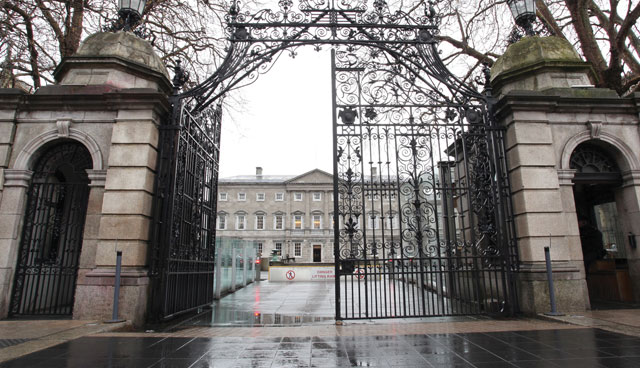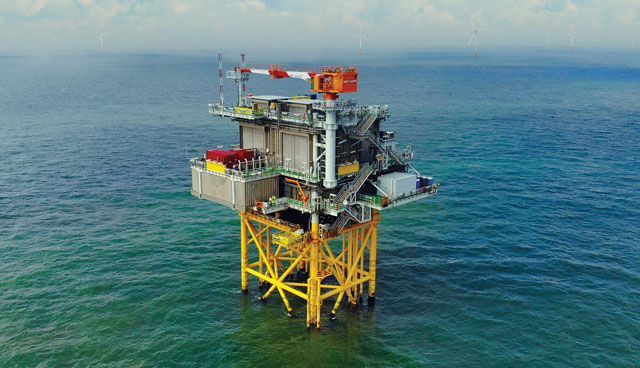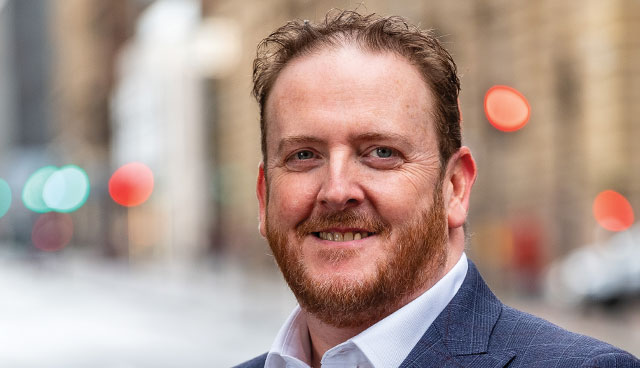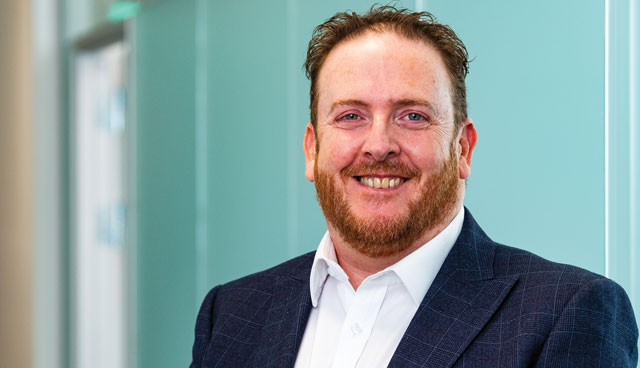
Efficiency, renewables and interconnection
8th December 2020
GE’s Grid Solutions: Your trusted partner in integrating offshore wind energy to the grid
8th December 2020Driving Ireland’s green recovery

Director of Capital Projects at SSE Renewables Paul Cooley discusses the opportunity presented for Ireland to build a green recovery through the renewable energy transition.
Welcoming the enhanced ambitions for renewable energy generation contained within the recent Programme for Government (PfG), including an ambitious 5GW capacity from offshore wind by 2030, Paul Cooley stresses the importance of Ireland moving at pace in order to remain competitive in a global movement.
“The raised ambitions of the Programme for Government offer real confidence to the industry to invest and should be welcomed. However, it should also be recognised that the decarbonisation journey is one being undertaken globally and so Ireland must move at pace to deliver those pathways that will see us reach those 2030 and 2050 targets.
“At a time when there is a recognition of the need for significant investment to rebuild the Irish economy, we have an opportunity to enhance our economy and our environment through investment in low carbon infrastructure.”
SSE recently submitted to government its Greenprint plan containing five policy priorities which it believes can kickstart economic activity in the life of this government.
The five priorities are:
1. Contribute to the delivery of 1GW offshore wind by 2025.
2. Continue the onshore wind success story.
3. Support customers to make the low carbon transition.
4. Provide flexible thermal generation for a net zero world.
5. Electrify heat and transport.
The Programme for Government is the latest iteration of Ireland’s ambitious plans to decarbonise its economy by 2050, recognising the financial and societal benefits that this will bring. Cooley highlights that this national journey somewhat mirrors the internal journey that has taken place within SSE.
Although boasting a long history in renewable development and operation in the UK and Ireland, in recent years SSE has restructured its business to focus on decarbonisation and the three key areas of renewables and networks, separated into transmission and distribution.
Cooley’s own business SSE Renewables has an existing portfolio of some 4GW of combined onshore wind, offshore wind and hydro across Ireland and the UK but as Cooley explains, also has its own ambition to treble its renewable energy output over the next decade to 2030.
“The 520MW Arklow Bank Wind Park can deliver 1 per cent of Ireland’s promised 7 per cent annual CO2 reductions by 2025.”
Setting out how this can be achieved, Cooley points to a focus on wind, expanding onshore wind and developing offshore wind, which he describes as the “fastest, lowest cost and most efficient” forms on delivering growth in renewables.
Offshore wind
Highlighting the inclusion of a fresh offshore target in the Programme for Government as offering confidence to the industry, Cooley points to SSE’s involvement in Phase 1 of the Arklow Bank Wind Park in 2003, the first and only operational offshore wind farm in Ireland, as being the last major development in this area.
“The PfG has offered confidence that there are measures coming, particularly to kick off the offshore wind industry. However, it’s very important that government follows up ambitious targets with measures to deliver on those.
“The key to offshore wind success will be the speed of delivery. Ireland is at the beginning of its journey and the ambition for 5GW by 2030 must be viewed in the context that it took the UK, a market 10 times the size of Ireland’s, 15 years to get their first 5GW. So, Ireland has an awful lot to do and moving as aggressively as possible will be really important.”
Describing the development of a Marine Planning and Development Management Bill (MPDM), a priority of government, as a positive step, he warns that the first projects through this process may not emerge until 2027-28 and stresses the need for some project delivery to commence as early as possible.
“The danger is that offshore wind is now a global market and there is competition for everything from investment to vessel and turbine availability. On Dogger Bank Wind Farm (the world’s largest offshore wind farm currently being developed off the Yorkshire coast through a joint venture between SSE Renewables and Equinor), for example, we have vessels booked out to 2026.
“Offshore might look easy because a lot of places are doing it around the world, but I wouldn’t underestimate the need to ramp up both confidence and the delivery of projects to deliver on that in Ireland.”
SSE Renewables are confident that they can lead on offshore wind development in Ireland, making a significant contribution to the 1GW of offshore wind target by 2025 set out by the Climate Action Plan.
Cooley outlines the belief that SSE Renewables can deliver Phase 2 of the Arklow Bank Wind Park, a 520MW project, by 2025. The project, when operational, will power around half a million homes and offset some half a million tonnes of carbon.
“Arklow is one of the small number of projects that already has consent and we think it’s important that projects with planning get away over the next five years rather than the whole industry waiting on the slowest project to catch up.”
Pointing to the UK’s possession of the largest offshore industry in the world, Cooley says that enabling projects delivering the first 5GW over 15 years were the major enablers of over four times that capacity being installed for the following decade.
“I believe that the RESS auction being put in place for 2021, with offshore development in mind, should focus on those trigger projects that can deliver before or around 2025,” he says. “The Government should prioritise routes to market and the necessary grid connections policy to make this a reality.”
Cooley envisages, Ireland’s offshore journey on three horizons. The first horizon is delivering on Ireland’s east coast, where nearshore and shallow water deployment enables fast deployment. “I think the majority of our 5GW target can easily be delivered from the east coast if we can navigate some of the challenges around the likes of consenting,” he explains.
On the south coast, where water gets deeper quickly and deployment will require a mixture of fixed bed and some floating technology, Cooley envisages a focus to 2030, as technology matures.
The third horizon is Ireland’s west coast, recognised as the most challenging conditions for various reasons ranging from the absence of grid to wave height and access limitations. SSE have extensive experience in such conditions through their work on the west coast of Scotland. “We’d view the west coast as all post-2030. There are big strategic challenges in this area and other routes to market will likely have to be considered including offshore hydrogen and greater interconnection.”
Onshore wind
Cooley is well aware that while a focus is required in deploying offshore electricity generation in Ireland, ambitions to decarbonise Ireland’s economy by 2050 will also require the continuation of Ireland’s success story in onshore wind. SSE Renewables has a number of projects in development to contribute to Ireland’s target of doubling onshore wind capacity by 2030 and recently their joint venture Lenalea Wind Farm (30.5MW in County Donegal) with Coillte Renewable Energy was successful in the first RESS auction.
In facilitating the expansion of onshore generation, Cooley welcomes the draft Wind Energy Guidelines for delivering a framework for developers but expresses concerns that “some proposals could unnecessarily restrict the development of onshore wind and Ireland’s ability to meet climate targets”.
In particular, Cooley says that noise restrictions, if implemented as they currently stand, will “harm the industry and development”. He notes that SSE Renewables believes the noise standards in particular require a very significant rewrite to be implementable and indeed, enforceable.
SSE Renewables have joined with others from the industry in submitting recommended changes through the consultation process and Cooley believes that it is important that the guidelines are finalised before the end of 2020, with industry concerns addressed.
Cooley believes that the recent RESS auction was necessary to inject fresh confidence in onshore development. He recognises that challenges that exist in this regard, particularly around grid capacity but acknowledges the strategic planning being undertaken by EirGrid to address this.
Interestingly, SSE’s focus is not solely on new developments and Cooley highlights a focus on re-powering existing infrastructure for increased efficiency. Having built a lot of the original onshore wind farms in Ireland, particularly around County Donegal, Cooley highlights that some are starting to approach end of life: “We’re starting to look at those sites where the technology was probably second generation and turbines were around 1-1.5MW with the view to repowering with much more modern and effective generation. That will bring usual grid and planning challenges, but the redevelopment of existing sites can bring a lot of value.
“However, we think there needs to be a mechanism to contractually support repowering or allowing it to feature in RESS auctions.”
Community benefit
A major focus of the decarbonisation transition has been on ensuring that communities buy in to the journey Ireland is on and benefit from it. Cooley sets out that the economic benefits aligned with a decarbonised economy include job creation, addressing regional imbalances, lower energy costs and an improved environment.
On wind farm development, he says: “We strongly believe in playing our part by contributing to the social, environmental and economic wellbeing of communities surrounding all of our wind farms. SSE Renewables has awarded an industry-leading over €10 million to communities across the island in the last decade, supporting more than 4,000 projects.
“We also support the offering to communities to invest in wind developments. The original RESS terms and conditions were problematic in that the eligibility criteria were broad and facilitated any Irish citizen to invest, even those living elsewhere in the EU. We raised concerns that that scheme would not promote social acceptance in renewable energy and that it didn’t align with the just transition. We were pleased to see the Department take account of industry concerns and look forward to working with government on new proposals in this area.”
Northern Ireland
Functioning across the UK and Ireland, SSE Renewables also has a stake in progress towards decarbonisation in Northern Ireland, including full engagement in the creation of a Northern Ireland Energy Strategy set to be finalised in 2021. Recently, the Department for the Economy Minister Diane Dodds stated her desire to see a 70 per cent target of electricity consumption from renewables set out for 2030.
While Cooley welcomes the setting of ambitious objectives, they alone will not attract private investment. “Actions speak louder than words and we’ve seen multiple wind projects, including SSE Renewables’ own Doraville Wind Farm, refused planning permission recently, often after planning processes which have taken years.
“The recent signals from Northern Ireland are that they are not open to investment in onshore wind, which is a pity given our Doraville project would have represented the largest single investment in the area at £150 million, providing significant opportunities to business across the region and in the local area.”
On how the Executive can re-inspire confidence in the area, Cooley outlines that he believes the region should commit to a more ambitious target of 80 per cent, which will help drive a green recovery.
“In Northern Ireland, the demand is relatively small in terms of renewable resource to decarbonise electricity and so we think the ambition should be to get their quicker and then focus on the heat and transport sectors out to 2050.”
Quizzed on the barriers to progress of decarbonisation in Northern Ireland, Cooley points to the planning system and the absence of a support scheme.
“RESS in Ireland has been the trigger for confidence to invest again. Merchant investments could happen and we’ve been doing some this way, but they will not be the majority of investments. The majority of renewables projects get delivered through fixed price contracts. Northern Ireland needs an RESS-type structure.
“Offshore projects with planning should get away in the next five years rather than wait on the slowest projects to catch up.”
“Additionally, we think there needs to be a step change in terms of delivering planning consents for renewables, as well as a vision for offshore. A small number of projects could be transformative for Northern Ireland given its size.
“So, some form of strategic planning is going to be needed around onshore wind and offshore wind, with a mechanism to pay for it all. Interestingly, the last few CFD auctions in the UK have shown a net benefit in those contracts. The concept of renewable electricity having a cost has been turned on its head in the last 24 months.”
Future
Looking to the future, Cooley restates his understanding that the decarbonisation of the economy starts with the decarbonisation of electricity. “The most efficient way to do that is through onshore and offshore wind. Delivering early on offshore is critical and delivering projects before 2025 will put Ireland on the map of offshore wind development.
“In the medium-term, there is a need for mechanism to deliver further offshore wind development and providing routes to market. In this regard the, NMPF is really important.
“Beyond 2030, the decarbonisation of electricity will facilitate the decarbonisation of heat and transport and be transformative to people’s lives and livelihoods and the economy. Ireland could be carbon negative with the natural resources we possess and that should be our ambition but in order to achieve that long-term transformation we must move quickly now.”
Paul Cooley
Prior to being appointed Director of Capital Projects at SSE Renewables, Cooley held positions as Director of Generation Development and Director of Performance Improvement within SSE’s Wholesale business and was also General Manager for SSE/Airtricity in Ireland.
Before joining the energy industry he held senior positions within the chemicals and manufacturing industry in the UK, Ireland and overseas, including operational, regulatory and engineering management roles at DuPont, Koch Industries and the Quinn Group. He has an Honours degree in Electrical Engineering from Queen’s University Belfast and lives in Troon, Scotland with his wife and three children.

